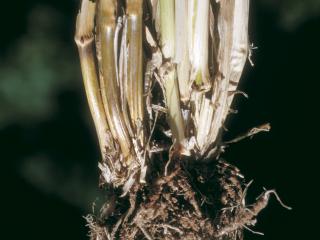Western Australia
October 13, 2014

Grain growers have been urged to watch out for soil-borne diseases, including crown rot – identified here by the browning on at the base of a barley plant.
Grain growers have been urged to keep watch in wheat and barley crops for the soil-borne disease, fusarium crown rot, after an increase in detections this year – particularly in the eastern wheatbelt.
The Department of Agriculture and Food has received reports from around Merredin of fusarium crown rot affecting between 30 to 50 per cent of wheat paddocks.
The reports are consistent with a constant demand on the Department of Agriculture and Food’s diagnostic service, AGWEST Plant Laboratories, to identify root diseases in samples from the central and northern region.
Soil-borne diseases, including crown rot, cost WA grain growers an estimated average of A$105 million per year in yield and quality losses.

Stephen Simpfendorfer, Senior Plant Pathologist, NSW DPI, (right) and DAFWA’s Daniel Hüberli presented at a fusarium crown rot ‘Pop Up’ field walk at Merredin Research Facility on 6 October.
DAFWA research officer Daniel Hüberli said the lead up to harvest was an important time to monitor crops and identify these diseases to assist planning to minimise their impact in 2015.
Crown rot predominantly affects wheat and barley. It is caused by Fusarium, a soil-borne fungus, infecting plants at the crown and reducing water supply to the stem. Affected plants show white head formation and failure to fill grain.
The disease also shows distinctive honey-brown discolouration of the stem base or lower node, when leaf sheaths are removed. Direct signs of the fungus may also be present as pink colouration.
“The increased expression this year is likely the result of intensive cereal production, in combination with 2013 and 2014 seasonal factors,” Dr Hüberli said.
In 2013, wet spring conditions probably contributed to disease build but with few white heads due to the soft finish. In 2014, the drier spring in many areas has resulted in a high expression of white head formation.
“Crop rotation to non-cereals is the key to management of affected paddocks as there are currently no fungicides registered to address crown rot. So paddock management decisions based on this year’s observations will be critical to next year’s cropping program,” Dr Hüberli said.
“Growers with white heads or other patchy, poor growth in paddocks are advised to check for the presence of the disease and confirm suspected infections by taking plant samples now or a soil sample after harvest. Samples can be dispatched to the AGWEST Plant Laboratories to confirm what soil-borne disease they may be dealing with.
“Armed with this information they can then make informed decisions about how to best plan their 2015 crops.”
Dr Hüberli said there was no single strategy to minimise the impact of soil-borne diseases so integrated paddock management was essential.
“If growers have a high risk of crown rot in their 2015 crop, they may choose to sow a non-cereal break crop or in low infestations sow a less susceptible variety, such as Emu Rock and use inter-row sowing,” he said.
With the support of the Grains Research and Development Corporation, the department has established research to assess management options and examine commonly grown wheat and barley variety for susceptibility to crown rot.
Further information about fusarium crown rot and related crop disease management is available on the department’s website, including testing services with AGWEST Plant Laboratories.